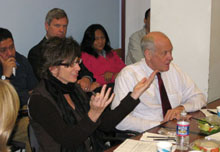
October 21, 2008 — Editor of washingtonpost.com Elizabeth Spayd has a print background, but an online future – a reflection of journalism today. Spayd spoke Tuesday about the future of newsrooms in a world increasingly focused towards online news content at a brown bag lunch sponsored by the Joan Shorenstein Center on the Press, Politics and Public Policy.
“From the time that I started, which was about 30 years ago … I’ve really seen a radical change in newsrooms,” said Spayd. “The biggest that I’ve ever seen, I feel like is taking place in the last couple years.”
According to Spayd, the move to online journalism, blogging, reporters with video cameras, podcasts, mobile Internet devices, RSS feeds, interactive graphics and the opportunities that come with the Internet is causing significant changes in the modern-day newsroom.
“You feel like you are navigating some of the traditional press into a very new world,” she said.
Spayd said there is tension between traditionalists who distrust online journalism and those who favor online – normally a younger generation of journalists. This tension is one of the significant challenges the modern newsroom faces.
Other challenges include the power of news aggregators like Google News and Yahoo! News taking hits away from Web sites’ home pages and the loss of advertising dollars when compared to print. Spayd said, however, that one of the benefits of online journalism is the ability to get online comments and immediate feedback from members of the public.
“I think we’re a less arrogant business as a result,” she said.
Though new journalists now need to possess video and audio experience, strong writing skills are still the most important thing the journalist of the future can offer.
“Reporting and journalistic skills … are the most important thing that I think you can develop,” said Spayd. “I think you’re much better off at focusing on good reporting, on developing sources, on your writing. But, adding to that, really looking on the Web, being out on the Web, looking at that form of story telling. And, if you can, to learn some video.”
Prior to being editor of washingtonpost.com, Spayd was the Washington Post‘s chief editor for national news, where she supervised coverage of national elections, the Sept. 11, 2001, terrorist attacks and Hurricane Katrina.
This article was written by Lindsay Hodges Anderson of the Harvard Kennedy School. The original article is here.

